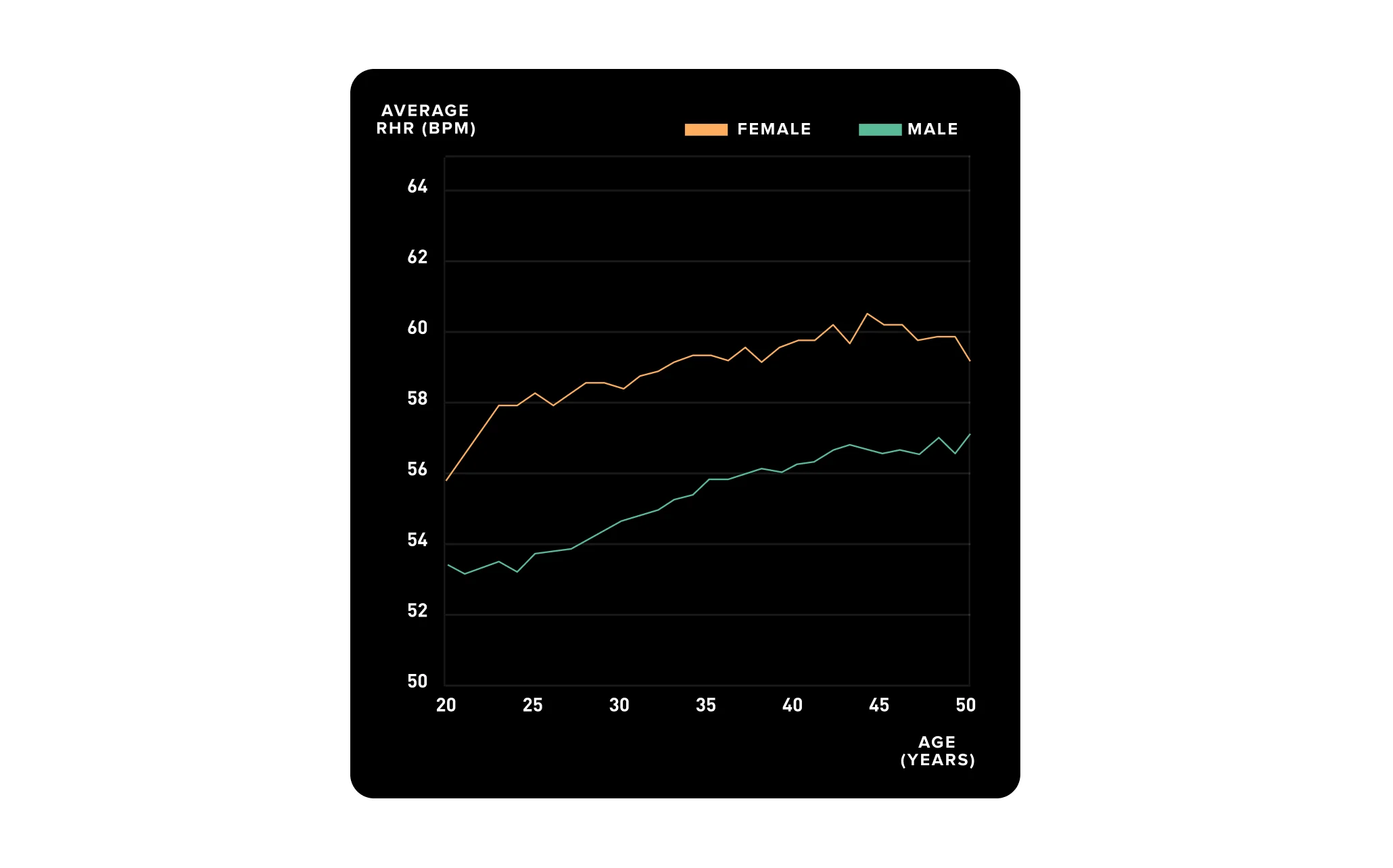Topics
- Article
- Heart Rate
What is a Good Resting Heart Rate by Age and Gender?

For most adults, a resting heart rate (RHR) between 60 and 100 beats per minute is normal and it generally increases with age, but there are many factors that can affect RHR.
What is resting heart rate (RHR)?
Resting heart rate (RHR), also called basal heart rate, is a measure of your average heart beats per minute (bpm) while your body is at rest in a neutrally temperate environment and has not been subject to recent strain. The metric is useful for monitoring your fitness level and heart health. A lower resting heart rate is usually a good sign. The average RHR is between 60-100 bpm, according to the American Heart Association. Generally speaking, when your heart rate decreases, it means that each beat is more effective. A low RHR is a sign of a strong heart muscle that can pump enough blood to supply the body with oxygen without having to labor too hard. When your heart doesn’t need to work as hard to push blood through your body to supply oxygen to your muscles, your level of fitness increases.
Women have higher RHRs than men
Women typically have smaller hearts than men do. As a result, each heartbeat produces less blood flow, meaning the heart needs to pump faster in order to achieve the necessary output. WHOOP data shows this translates into an average RHR about 3.5 bpm higher for females than males. Across all ages, the average resting heart rate for women wearing WHOOP is 58.8 bpm, and for men it’s 55.2 bpm. Since many of our members tend to be athletes and/or people who are particularly interested in monitoring their health and well-being, it’s not surprising that the normal RHR for men and women on WHOOP is below what the Center of Disease Control considers average.
Resting heart rate chart: breakdown by age and gender
As we age our RHR changes, increasing until around 40 years old and then leveling off. The charts below show how resting heart rates of WHOOP members and Americans overall vary by gender and change over time.

Average RHR by age for male and female WHOOP members.

RHR by age and gender for the average adult, based on data from the US DEPARTMENT OF HEALTH AND HUMAN SERVICES.
Factors that affect resting heart rate
Prolonged stress can increase RHR and lead to a higher risk of heart attack and stroke. Overall, 60% of the time WHOOP members input experiencing stress (via the WHOOP Journal feature) it results in an increase in resting heart rate. Our data indicates men and women see similar changes in RHR due to stress in most age groups. Other emotions, such as happiness, can also raise your RHR. More factors that affect RHR include:
- Weight--there is a correlation between RHR and body mass index (BMI). High BMI is associated with elevated RHR according to this study.
- Pregnancy can increase RHR.
- Coffee and caffeinated drinks can temporarily raise your RHR.
- Smoking increases RHR. Researchers at University College London found that RHR decreases by an average 5–15 bpm within a day of stopping smoking and remains at that level for at least a year.
- Consuming alcohol can increase RHR.
- Decongestants or allergy medications may elevate RHR.
- Blood pressure medications such as Beta blockers and some migraine medications can lower RHR.
- Disorders such as anemia, hyperthyroidism and hypothyroidism can affect RHR.
- Chronic sleep deprivation can lead to a lower metabolism and raise RHR.
- High air temperatures and high humidity can increase RHR.
- Body position--RHR can be 3 bpm higher when sitting versus lying down and rises upon standing, according to Harvard Health Publishing.

When WHOOP members report stress, RHR increases by an average of 1 beat per minute.
What can resting heart rate readings indicate?
Your heart rate varies from minute to minute, but your RHR tends to remain fairly stable from day to day. Altogether, there is a wide range of normal RHR, depending on gender, age and many other factors, however, experiencing unusually high or low RHR may indicate an underlying problem. In adults, a lower RHR is correlated with a higher degree of fitness and lower incidence of cardiac events. A consistently higher RHR may be associated with cardiovascular issues.
How to improve RHR
Starting to improve RHR can be as easy as walking out the door. A brisk walk will elevate your heart rate during the activity and for a short period after, and exercising daily gradually decreases your RHR. Swimming, cycling, and other activities that target the aerobic heart rate zone will also help lower your RHR and benefit your overall fitness level.
How WHOOP tracks your RHR
Monitoring RHR on your own can be quite difficult and often inaccurate. WHOOP calculates your RHR while you’re sleeping each night using a dynamic average weighted towards your deepest periods of sleep, when your body is in its most restful state. This allows for extremely reliable and consistent readings. You can track your RHR trends in our app and note behaviors that may affect your RHR in the Journal. Additionally, WHOOP uses your RHR (along with heart rate variability, respiratory rate and sleep performance) to calculate your recovery each morning, so you can get a daily “physical forecast” for your body. Learn More: What Your Normal Vital Signs Mean
Resting Heart Rate FAQs
What is an unhealthy resting heart rate?
An unhealthy resting heart rate is one that is consistently above or below the normal range of 60 to 100 beats per minute. A resting heart rate that is consistently above 100 bpm may indicate a condition such as tachycardia, while a resting heart rate that is consistently below 60 bpm may indicate bradycardia. It is important to consult with a healthcare professional to determine the cause and appropriate treatment for an unhealthy resting heart rate.
Is resting heart rate a good indicator of health?
Resting heart rate can be a good indicator of health, as a lower resting heart rate generally indicates better cardiovascular fitness. However, there are many factors that can affect resting heart rate, such as age, medication use, and medical conditions, so it should not be relied upon as the sole indicator of overall health. Other factors such as blood pressure, cholesterol levels, and lifestyle habits should also be considered.
Is 80 a healthy resting heart rate?
An 80 bpm resting heart rate is generally considered within the normal range for adults. However, what is considered "healthy" may vary based on an individual's age, medical history, and lifestyle factors. As always, consult with a healthcare professional to determine if a resting heart rate of 80 bpm is appropriate for an individual.